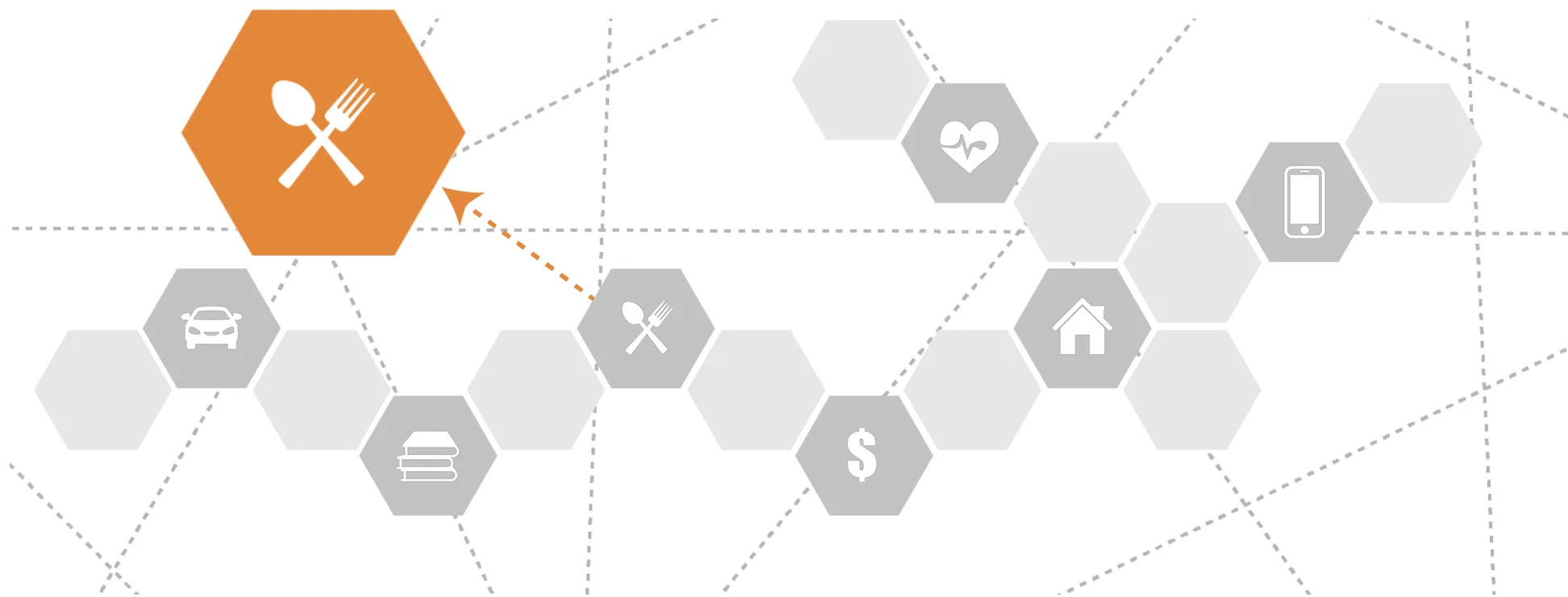
|
Housingclick to view |

|
Health Careclick to view |

|
Child Care and Educationclick to view |

|
Technologyclick to view |

|
Foodclick to view |

|
Taxesclick to view |

|
Transportationclick to view |
||
Impact on ALICE
What do families do when they cannot afford food?
Finding enough affordable, high-quality, healthy food is continually or periodically a challenge for many families. No community is immune to this problem. There are several common strategies that families try when they can’t afford food, but those strategies don’t always succeed, and can sometimes even cause new problems.
Cut Back on Food Spending
When ALICE and poverty-level households do not have enough money for food, they often have no alternative but to buy less food or, less healthy food. Almost 80 percent of food-insecure families reported purchasing inexpensive, unhealthy food; more than half ate food that was past its expiration date; half purchased food in dented or damaged packages; and 40 percent watered down their food or drinks.8
When ALICE and poverty-level households do not have enough money for food, they often have no alternative but to buy less food or, less healthy food. Almost 80 percent of food-insecure families reported purchasing inexpensive, unhealthy food; more than half ate food that was past its expiration date; half purchased food in dented or damaged packages; and 40 percent watered down their food or drinks.8

Seek Food Assistance
Overall, the use of government food programs, as well as soup kitchens, food pantries, and food banks, has increased steadily from the Great Recession to the present. Supplemental Nutrition Assistance Program (SNAP, formerly food stamps) benefits have proven to be effective in combating hunger and poverty; SNAP beneficiaries experience less food insecurity, fewer sick days, and fewer hospital and doctor visits. Eighty-four percent of SNAP benefits go to households with children, seniors, or people with disabilities.19 SNAP and the Special Supplemental Nutrition Program for Women, Infants, and Children (WIC) together improve short-term and long-term maternal and child health outcomes and bolster children’s academic achievement.20
With these benefits, 85 percent of those eligible for SNAP participated in 2016.21 Barriers to participation include lack of access to assistance, the stigma of receiving assistance, eligibility limits, and insufficient federal food benefits.22
Overall, the use of government food programs, as well as soup kitchens, food pantries, and food banks, has increased steadily from the Great Recession to the present. Supplemental Nutrition Assistance Program (SNAP, formerly food stamps) benefits have proven to be effective in combating hunger and poverty; SNAP beneficiaries experience less food insecurity, fewer sick days, and fewer hospital and doctor visits. Eighty-four percent of SNAP benefits go to households with children, seniors, or people with disabilities.19 SNAP and the Special Supplemental Nutrition Program for Women, Infants, and Children (WIC) together improve short-term and long-term maternal and child health outcomes and bolster children’s academic achievement.20
With these benefits, 85 percent of those eligible for SNAP participated in 2016.21 Barriers to participation include lack of access to assistance, the stigma of receiving assistance, eligibility limits, and insufficient federal food benefits.22

Put Aside Other Needs
ALICE and poverty-level households put aside other needs, such as medical care, in order to afford food. As an ALICE family’s food costs rise, other current needs are compromised, including doctor visits and medicine, child care, heat and other utilities, or housing itself. These deprivations, as well as the stress they cause, can actually increase the need for health care, which becomes yet another expense.30
Food-insecure families are more likely than other households to put off health care and buying or taking medications, yet more likely to need it. Children in food-insecure households are less likely to go to recommended well-child visits.31 Dental care is even more likely to be sacrificed, with many food-insecure households reporting that they had not visited a dentist in the last five years.32
ALICE and poverty-level households put aside other needs, such as medical care, in order to afford food. As an ALICE family’s food costs rise, other current needs are compromised, including doctor visits and medicine, child care, heat and other utilities, or housing itself. These deprivations, as well as the stress they cause, can actually increase the need for health care, which becomes yet another expense.30
Food-insecure families are more likely than other households to put off health care and buying or taking medications, yet more likely to need it. Children in food-insecure households are less likely to go to recommended well-child visits.31 Dental care is even more likely to be sacrificed, with many food-insecure households reporting that they had not visited a dentist in the last five years.32

Sources
8
Feeding America. (2014). Hunger in America 2014: National report. Retrieved from http://help.feedingamerica.org/HungerInAmerica/hunger-in-america-2014-full-report.pdf
9
Feeding America. (2014). Hunger in America 2014: National report. Retrieved from http://help.feedingamerica.org/HungerInAmerica/hunger-in-america-2014-full-report.pdf
RTI International. (2014). Current and prospective scope of Hunger and food security in America. Retrieved from http://www.rti.org/sites/default/files/resources/full_hunger_report_final_07-24-14.pdf
The Aspen Institute. (2016, March 1). Advancing health through food security. Retrieved from https://www.aspeninstitute.org/publications/advancing-health-through-food-security-0/
10
Feeding America. (2014). Hunger in America 2014: National report. Retrieved from http://help.feedingamerica.org/HungerInAmerica/hunger-in-america-2014-full-report.pdf
RTI International. (2014). Current and prospective scope of Hunger and food security in America. Retrieved from http://www.rti.org/sites/default/files/resources/full_hunger_report_final_07-24-14.pdf
11
Cook, J., & Jeng, K. (2009). Child food security: The economic impact on our nation. Feeding America. Retrieved from https://www.nokidhungry.org/sites/default/files/child-economy-study.pdf
12
RTI International. (2014). Current and prospective scope of Hunger and food security in America. Retrieved from http://www.rti.org/sites/default/files/resources/full_hunger_report_final_07-24-14.pdf
The Aspen Institute. (2016, March 1). Advancing health through food security. Retrieved from https://www.aspeninstitute.org/publications/advancing-health-through-food-security-0/
Fuller-Thompson, E., & Redmond, M. (2008). Falling through the social safety net: Food stamp use and nonuse among older impoverished Americans. The Gerenotologist. Retrieved from https://www.researchgate.net/publication/5369053_Falling_Through_the_Social_Safety_Net_Food_Stamp_Use_and_Nonuse_Among_Older_Impoverished_Americans
13
Feeding America. (2014). Hunger in America 2014: National report. Retrieved from http://help.feedingamerica.org/HungerInAmerica/hunger-in-america-2014-full-report.pdf
RTI International. (2014). Current and prospective scope of Hunger and food security in America. Retrieved from http://www.rti.org/sites/default/files/resources/full_hunger_report_final_07-24-14.pdf
The Aspen Institute. (2016, March 1). Advancing health through food security. Retrieved from https://www.aspeninstitute.org/publications/advancing-health-through-food-security-0/
Seligman, H., Laraia, B., & Kushel, M. (2010, February). Food insecurity is associated with chronic disease among low-income NHANES participants. The Journal of Nutrition, 140(2). Retrieved from http://www.ncbi.nlm.nih.gov/pmc/articles/PMC2806885/
14
Mozaffarian, D. (2018, December). CIPR Study: Rising health care costs: Drivers, challenges, and solutions. National Association of Insurance Commissioners. Retrieved from https://www.naic.org/documents/cipr_study_1812_health_care_costs.pdf
15
Berkowitz, S. A., Basu, S., Meigs, J. B., & Selgman, H. K. (2018). Food insecurity and health care expenditures in the United States, 2011–2013. Health Services Research, 53(3), 1600–1602. Retrieved from https://onlinelibrary.wiley.com/doi/abs/10.1111/1475-6773.12730
16
Hanson, K. (2008). Mollie Orshansky’s strategy to poverty measurement as a relationship between household food expenditures and economy food plan. Review of Agricultural Economics, 30(3), 572–580. Retrieved from http://handle.nal.usda.gov/10113/20301
AARP Foundation. (2015). Food insecurity among older adults. Retrieved from http://www.aarp.org/content/dam/aarp/aarp_foundation/2015-PDFs/AF-Food-Insecurity-2015Update-Final-Report.pdf
17
Lee-Kwan, S. H., Moore, L. V., Blanck, H. M., Harris, D. M., & Galuska, D. (2017). Disparities in state-specific adult fruit and vegetable consumption — United States, 2015. CDC Morbidity and Mortality Weekly Report. Retrieved from https://www.cdc.gov/mmwr/volumes/66/wr/mm6645a1.htm?s_cid=mm6645a1_w
18
Centers for Disease Control and Prevention (CDC). (2013). State indicator report on fruits and vegetables, 2018. Retrieved from https://www.cdc.gov/nutrition/downloads/fruits-vegetables/2018/2018-fruit-vegetable-report-508.pdf
19
Food Research & Action Center. (2018). SNAP benefits need to be made adequate, not cut or restricted. Retrieved from http://frac.org/wp-content/uploads/snap-food-choice.pdf
20
Betley, C. L., Szanton, S., Samuel, L., & Cahill, R. (2016). State and federal income support programs and effects on dual eligible health care use and cost. The Hilltop Institute, University of Maryland, Baltimore County.
Furman, J., Munoz, C., & Black, S. (2015). New CEA report finds that SNAP benefits are crucial for families but sometimes inadequate. Retrieved from https://obamawhitehouse.archives.gov/blog/2015/12/08/new-cea-report-finds-snap-benefits-are-crucial-families-sometimes-inadequate
U.S. Department of Agriculture (USDA). (2013). About WIC — How WIC helps. Retrieved from https://www.fns.usda.gov/wic/about-wic-how-wic-helps
21
Cunnyngham, K. (2018, July). Current perspectives on SNAP participation: Trends in Supplemental Nutrition Assistance Program participation rates: Fiscal year 2010 to fiscal year 2016. U.S. Department of Agriculture. Retrieved from https://fns-prod.azureedge.net/sites/default/files/snap/Trends2010-2016.pdf
22
Feeding America. (2014). Hunger in America 2014: National report. Retrieved from http://help.feedingamerica.org/HungerInAmerica/hunger-in-america-2014-full-report.pdf
23
Hanson, K., & Oliveira, A. (2012, September). How economic conditions affect participation in USDA nutrition assistance programs. U.S. Department of Agriculture. Retrieved from https://www.ers.usda.gov/webdocs/publications/43667/32191_eib100.pdf
24
Wimer, C., Wright, R., & Fong, K. (2013, February). The cost of free assistance: Studying nonuse of food assistance in San Francisco. Institute for Research on Poverty. Retrieved from http://www.irp.wisc.edu/publications/dps/pdfs/dp140813.pdf
Bertmann, F., Barroso, C., Ohri-Vachaspati, P., Hampl, J., Sell, K., & Wharton, C. (2014, May). Women, infants, and children cash value voucher (CVV) use in Arizona: A qualitative exploration of barriers and strategies related to fruit and vegetable purchases. Journal of Nutrition Education and Behavior, 46(3 Suppl), S53–58. Retrieved from http://europepmc.org/abstract/med/24809997
25
Food Research & Action Center. (2018). SNAP benefits need to be made adequate, not cut or restricted. Retrieved from http://frac.org/wp-content/uploads/snap-food-choice.pdf
26
Betley, C. L., Szanton, S., Samuel, L., & Cahill, R. (2016). State and federal income support programs and effects on dual eligible health care use and cost. The Hilltop Institute, University of Maryland, Baltimore County.
27
Food Research & Action Center. (2018). SNAP benefits need to be made adequate, not cut or restricted. Retrieved from http://frac.org/wp-content/uploads/snap-food-choice.pdf
Institute of Medicine (IOM). (2013, January). Supplemental Nutrition Assistance Program: Examining the evidence to define benefit adequacy. Retrieved from http://iom.nationalacademies.org/~/media/Files/Report%20Files/2013/SNAP/SNAP_RB.pdf
28
Food Research & Action Center. (2018). SNAP benefits need to be made adequate, not cut or restricted. Retrieved from http://frac.org/wp-content/uploads/snap-food-choice.pdf
Institute of Medicine (IOM). (2013, January). Supplemental Nutrition Assistance Program: Examining the evidence to define benefit adequacy. Retrieved from http://iom.nationalacademies.org/~/media/Files/Report%20Files/2013/SNAP/SNAP_RB.pdf
Feeding America. (2014). Hunger in America 2014: National report. Retrieved from http://help.feedingamerica.org/HungerInAmerica/hunger-in-america-2014-full-report.pdf
29
Betley, C. L., Szanton, S., Samuel, L., & Cahill, R. (2016). State and federal income support programs and effects on dual eligible health care use and cost. The Hilltop Institute, University of Maryland, Baltimore County. Retrieved from http://www.hilltopinstitute.org/publications/ARM%202016/StateAndFederalIncomeSupportPrograms-June2016.pdf
30
Feeding America. (2014). Hunger in America 2014: National report. Retrieved from http://help.feedingamerica.org/HungerInAmerica/hunger-in-america-2014-full-report.pdf
RTI International. (2014). Current and prospective scope of Hunger and food security in America. Retrieved from http://www.rti.org/sites/default/files/resources/full_hunger_report_final_07-24-14.pdf
The Aspen Institute. (2016, March 1). Advancing health through food security. Retrieved from https://www.aspeninstitute.org/publications/advancing-health-through-food-security-0/
Seligman, H., Laraia, B., & Kushel, M. (2010, February). Food insecurity is associated with chronic disease among low-income NHANES participants. The Journal of Nutrition, 140(2). Retrieved from http://www.ncbi.nlm.nih.gov/pmc/articles/PMC2806885/
31
Institute of Medicine (IOM). (2013, January). Supplemental Nutrition Assistance Program: Examining the evidence to define benefit adequacy. Retrieved from http://iom.nationalacademies.org/~/media/Files/Report%20Files/2013/SNAP/SNAP_RB.pdf
32
Harrison, G. (2003). Household food insecurity, food assistance program participation, and the use of preventive medical care. School of Public Health and Center for Health Policy Research. Retrieved from https://data.ers.usda.gov/FANRP-ridge-project-summaries.aspx?type=2&summaryId=104
Chi, D., Masterson, E., Carle, A., Mancl, L., & Coldwell, S. (2014). Socioeconomic status, food security, and dental caries in US children: Mediation analyses of data from the National Health and Nutrition Examination Survey, 2007–2008. American Journal of Public Health, 104(5), 860–864. Retrieved from http://doi.org/10.2105/AJPH.2013.301699
33
Food Research & Action Center. (n.d.). Consequences of poor nutrition. Retrieved from http://frac.org/obesity-health/consequences-poor-nutrition
Centers for Disease Control and Prevention. (n.d.). Health effects of limited access to healthy food: Obesity, chronic disease, and poor nutrition. Retrieved from https://www.cdc.gov/healthyplaces/healthtopics/healthyfood/obesity.htm
34
Feeding America. (2014). Hunger in America 2014: National Report. Retrieved from https://www.cdc.gov/healthyplaces/healthtopics/healthyfood/obesity.htm
35
Belsky, E., Goodman, J., & Drew, R. (2005, June). Measuring the nation’s rental housing affordability problems. Joint Center for Housing Studies of Harvard University. Retrieved from http://www.jchs.harvard.edu/sites/jchs.harvard.edu/files/rd05-1_measuring_rental_affordability05.pdf
National Low Income Housing Coalition. (2016). Out of Reach 2016: No Refuge for Low Income Renters. Retrieved from https://nlihc.org/sites/default/files/oor/OOR_2016.pdf

